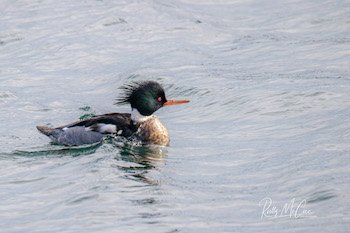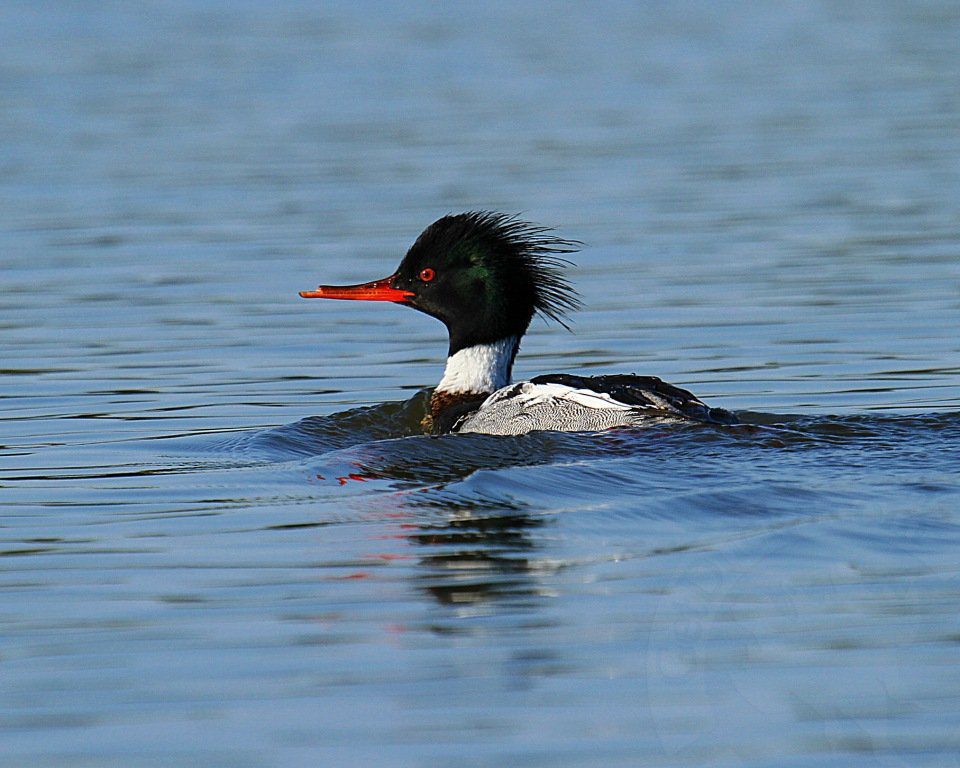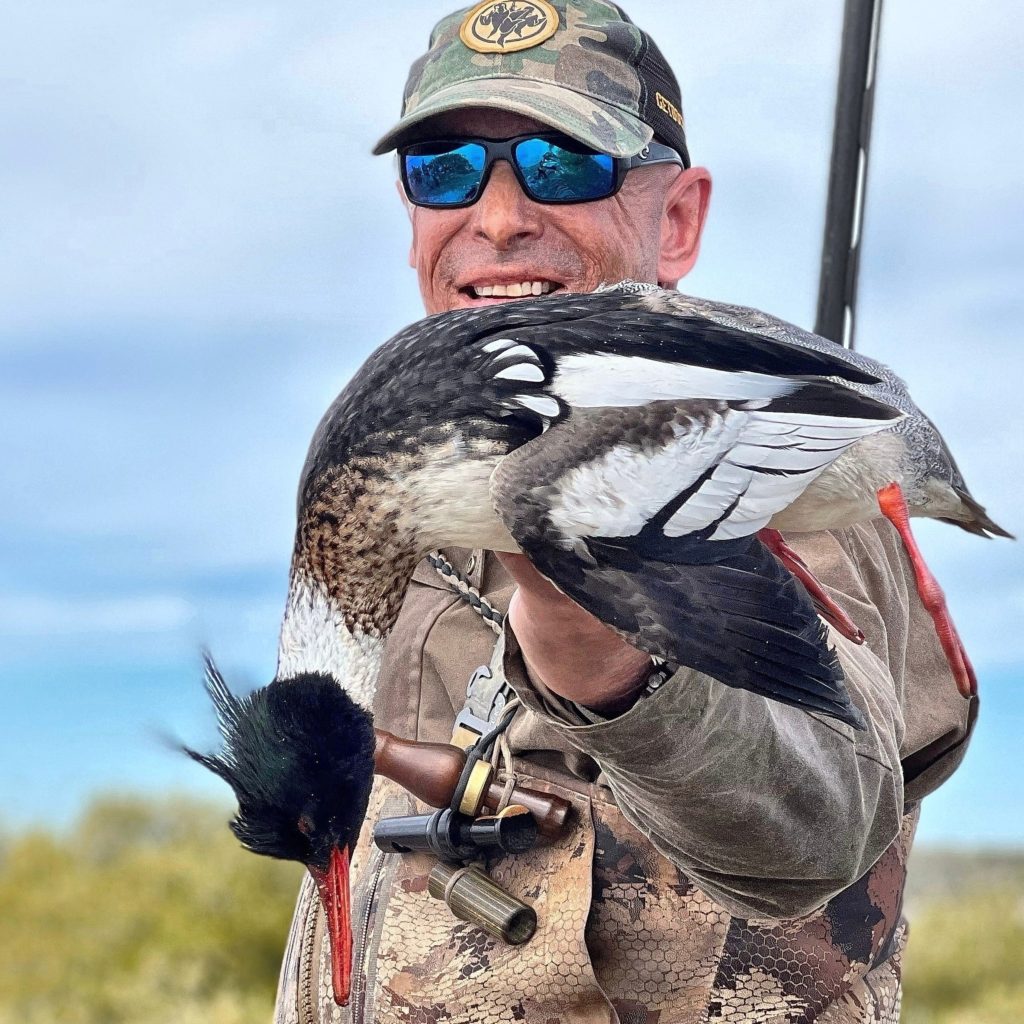Red-breasted Merganser
 Red-breasted Merganser (Mergus serrator) has the same long, serrated bill and diving efficiency as the other species in the family, although they display a shaggy greenish-black crest. Below the head, a small white collar quickly transitions to a dappled brown breast. The drake shows a white underbelly, gray vermiculated sides, and prominent horizontal white spots in the black plumage behind the breast. Red-breasted mergansers defining characteristic is rapid flying speed (up to 81 miles per hour) right above the water, flashing white coverts and secondaries that are wider than other merganser species. The male has blood-red irises and a bill that ranges in color from bright red to a muted orange. Hens closely resemble those of the Common Merganser, but the Red-breasted Merganser is smaller, displays more mottled gray mid-body plumage, and has a much lighter chin patch.
Red-breasted Merganser (Mergus serrator) has the same long, serrated bill and diving efficiency as the other species in the family, although they display a shaggy greenish-black crest. Below the head, a small white collar quickly transitions to a dappled brown breast. The drake shows a white underbelly, gray vermiculated sides, and prominent horizontal white spots in the black plumage behind the breast. Red-breasted mergansers defining characteristic is rapid flying speed (up to 81 miles per hour) right above the water, flashing white coverts and secondaries that are wider than other merganser species. The male has blood-red irises and a bill that ranges in color from bright red to a muted orange. Hens closely resemble those of the Common Merganser, but the Red-breasted Merganser is smaller, displays more mottled gray mid-body plumage, and has a much lighter chin patch.
Available Hunts
-
Mexico Duck Hunting Obregon
Mexico duck hunt combo for real duck hunters. All-day hunts for broad variety of Central Flyway and Pacific Flyway duck species.
...read moreMexico duck hunting combo in Obregon is an action-packed “real duck hunters duck hunt” for ducks, doves, options for trophy bass fishing and quail.
- Trophy duck species for nearly all Central and Pacific flyway species to include cinnamon teal, Mexican mallard, more!
- Generous bag limits
- Elegant and Gambel’s quail, trophy largemouth bass fishing options
- Premium, 9-bedroom estancia and unequalled guest services
- Featured – Wildfowl, World of Beretta, MOJO TV, Outdoor Life, NRA Hunter, more
Rate: $4,880 (4-day hunt) -
New England Sea Duck Hunting
World renown for its eider hunting, New England waterfowling offers an incredible change of scenery and is an excellent place to check off lots of North America waterfowl species. RPM Outdoors specializes in making your hunt priorities a reality.
...read more- Decade-plus experience for trophy eiders, other sea ducks, divers, dabblers, mergansers, geese
- Best place in US to harvest prime American black ducks
- Customized hunt plans reflect hunter priorities, not a “one size fits all” type 1/2-day hunt
- Includes hotel accommodations, full-day hunting, continental breakfasts, made-to-order lunches
- Recognized as foremost among US waterfowl collectors and taxidermists
- Nearby non-hunting spouse activities abound
Rate: $1,950 for 3-day inclusive package
 Red-breasted mergansers have an extremely limited residential range to include southern coastal Alaska, the Aleutian Islands, eastern Quebec, and Nova Scotia. This species finds suitable habitats near saltwater or brackish waters more often than do common mergansers. Foraging areas differ from other merganser species; they favor shallow water with ample submerged vegetation. Red-breasted mergansers diet is predominately small fish-like minnows that they will herd into inescapable areas. Red-breasted Mergansers also feed on tadpoles and terrestrial and aquatic invertebrates.
Red-breasted mergansers have an extremely limited residential range to include southern coastal Alaska, the Aleutian Islands, eastern Quebec, and Nova Scotia. This species finds suitable habitats near saltwater or brackish waters more often than do common mergansers. Foraging areas differ from other merganser species; they favor shallow water with ample submerged vegetation. Red-breasted mergansers diet is predominately small fish-like minnows that they will herd into inescapable areas. Red-breasted Mergansers also feed on tadpoles and terrestrial and aquatic invertebrates.
Migratory red-breasted mergansers’ breeding grounds range throughout Alaska, the northern half of Canada, Minnesota, Wisconsin, Michigan, and Maine. Their breeding range is the most northern of any American merganser species. Red-breasted Mergansers do not nest in cavities, instead choosing to make ground nests in dense vegetation near water. Red-breasted mergansers winters around the Atlantic, Gulf of Mexico, and Pacific Coasts with smaller populations found in the western United States and as far south as the Sea of Cortez.
RED-BREASTED MERGANSER. Swinging hell-bent off the open bay and into quiet cove, mere inches above the water, a pair of streaking blurs fueled by rapid wing beats, coming to feed on fishes the tide was pushing around, same as the short brown humans in the blue wooden pango that were casting nets towards a nearby shoal. Swinging through the rear bird and allowing about a Silverado’s worth of lead, the pattern engulfed him at the trigger-pull and he skipped like a lifeless stone across brown brackish water. Char Dawg soon returned with her own new species. A large sawbill, red-breasted mergansers are also the most handsome in my opinion. Dark green head with spiked crests, fiercely red bill and feet, white neck with pebbled sand-colored breast, a black back, heavily vermiculated rump, white underparts. Black and white flashing rocket-powered darts seen over the water at a distance. In hand, large white painted tear drops preceding side pockets. Beautiful. And fast. It’s been said that red-breasted mergansers have been clocked at about 100 mph. I’ve seen antique red-breasted decoys, tufts of horse mane tucked into the wooden heads to fashion the crest, so i know they were once targeted for the table, but I’ve never had the courage to cook these fish-eaters in the modern era. One of 2 final species collected for the “41,” the handful I’ve taken were all destined for the game room, and all were taken in bays along Mexico’s Sea of Cortez. I can’t recall seeing as many elsewhere I’ve hunted.




















